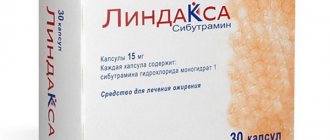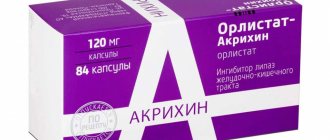Xenical®
Clinical trial data
The following categories are used to describe the frequency of adverse reactions: very common (≥1/10), common (≥1/100, <1/10), uncommon (≥1/1000, <1/100), rare (≥1/10000 , <1/1000) and very rarely (<1/10000), including isolated cases.
Adverse reactions to orlistat occurred mainly from the gastrointestinal tract and were due to the pharmacological effect of the drug, which interferes with the absorption of dietary fats. The incidence of adverse events decreased with long-term use of orlistat.
The following adverse events occurred with an incidence of >2% and an incidence of ≥1% compared with placebo.
Infectious and parasitic diseases:
very often - influenza.
Metabolic disorders:
very often - hypoglycemia*.
Mental disorders:
often - anxiety.
Nervous system disorders
: very often - headache.
Disorders of the respiratory system, chest and mediastinal organs:
very often - upper respiratory tract infection; often - lower respiratory tract infection.
Gastrointestinal disorders:
very often - pain or discomfort in the abdomen, oily discharge from the rectum, release of gases with some discharge, urgency to defecate, steatorrhea, flatulence, loose stools, increased frequency of bowel movements; often - pain or discomfort in the rectum, “soft” stools, fecal incontinence, dental damage, gum damage, bloating*.
Renal and urinary tract disorders
: often - urinary tract infections.
Genital and breast disorders
: often - irregular menstruation.
General and administration site disorders
: often - weakness.
In patients with type 2 diabetes mellitus, the nature and frequency of adverse events were comparable to those in overweight and obese individuals without diabetes mellitus.
*The only new adverse events in obese patients with type 2 diabetes were hypoglycemic conditions (very common) and abdominal bloating (common), occurring at an incidence of >2% and an incidence of ≥1% compared with placebo.
The incidence of gastrointestinal disorders increases with increasing dietary fat content. Patients should be informed of the possibility of gastrointestinal adverse reactions and taught how to manage them through better dietary management, especially regarding the amount of fat contained in the diet. Adopting a low-fat diet reduces the likelihood of gastrointestinal side effects and thereby helps patients control and regulate their fat intake.
As a rule, these adverse reactions are mild and transient. They occurred in the early stages of treatment (in the first 3 months), and most patients had no more than one episode of such reactions.
In the 4-year clinical study, the overall safety profile did not differ from that obtained in the 1- and 2-year studies. At the same time, the overall incidence of adverse events from the gastrointestinal tract decreased annually over the 4-year period of taking the drug.
Post-marketing surveillance
The adverse events listed below were identified in spontaneous post-marketing reports, the frequency of development is unknown.
Immune system disorders:
hypersensitivity reactions, the main clinical symptoms of which were itching, rash, urticaria, angioedema, bronchospasm and anaphylaxis.
Gastrointestinal disorders:
rectal bleeding, diverticulitis, pancreatitis.
Disorders of the liver and biliary tract:
cholelithiasis, isolated, possibly serious, cases of liver damage leading to liver transplantation or death.
Skin and subcutaneous tissue disorders
: bullous rash.
Renal and urinary tract disorders
: oxalate nephropathy, which can sometimes lead to kidney failure.
Laboratory abnormalities:
increased activity of “liver” transaminases and alkaline phosphatase, decreased prothrombin concentrations, increased international normalized ratio (INR) values and cases of unbalanced anticoagulant therapy, which led to changes in hemostatic parameters (see section “Interaction with other drugs”).
When taking orlistat and antiepileptic drugs simultaneously, cases of seizures have been observed (see section “Interaction with other drugs”).
Cases of hyperoxaluria have been reported.
Xenical
Xenical is a powerful, specific and reversible inhibitor of gastrointestinal lipases with a long-lasting effect. Its therapeutic effect occurs in the lumen of the stomach and small intestine and consists of the formation of a covalent bond with the active serine site of gastric and pancreatic lipases. The inactivated enzyme then loses the ability to break down food fats, which come in the form of triglycerides, into absorbable free fatty acids and monoglycerides. Since unsplit triglycerides are not absorbed, the resulting decrease in caloric intake into the body leads to a decrease in body weight. Thus, the therapeutic effect of the drug is carried out without absorption into the systemic circulation.
Based on fecal fat results, the effects of orlistat begin 24 to 48 hours after dosing. After discontinuation of the drug, the fat content in stool usually returns to pre-therapy levels within 48-72 hours.
Efficiency
Obese patients
In clinical studies, patients taking orlistat experienced greater weight loss compared to patients on diet therapy. Weight loss began within the first 2 weeks after the start of treatment and lasted from 6 to 12 months, even in patients with a negative response to diet therapy. Over the course of 2 years, there was a statistically significant improvement in the profile of metabolic risk factors associated with obesity. In addition, compared to placebo, there was a significant reduction in body fat. Orlistat is effective in preventing weight gain. Re-gain of body weight, no more than 25% of what was lost, was observed in approximately half of the patients, and in half of these patients, no re-gain of body weight was observed or even a further decrease was observed.
Obese patients with type 2 diabetes mellitus In clinical studies lasting 6 months to 1 year, overweight or obese patients with type 2 diabetes mellitus treated with orlistat experienced greater weight loss compared with patients treated with diet therapy alone. Body weight loss occurred mainly due to a decrease in the amount of fat in the body. It should be noted that before the start of the study, despite taking hypoglycemic agents, patients often had insufficient glycemic control. However, with orlistat therapy, a statistically and clinically significant improvement in glycemic control was observed. In addition, during orlistat therapy, a decrease in doses of hypoglycemic agents, insulin concentrations, and a decrease in insulin resistance were observed.
Reducing the risk of developing type 2 diabetes in obese patients
In a 4-year clinical study, orlistat was shown to significantly reduce the risk of developing type 2 diabetes (by approximately 37% compared to placebo). The degree of risk reduction was even greater in patients with baseline impaired glucose tolerance (approximately 45%). There was greater weight loss in the orlistat treatment group compared to the placebo group. Maintaining body weight at a new level was observed throughout the entire study period. Moreover, compared with placebo, patients treated with orlistat showed a significant improvement in their metabolic risk factor profile.
Pubertal obesity
In a 1-year clinical trial in obese adolescents, orlistat was associated with a decrease in body mass index compared with placebo, which even increased body mass index. In addition, patients in the orlistat group showed a decrease in fat mass, as well as waist and hip circumferences compared to the placebo group. Also, patients receiving orlistat therapy experienced a significant reduction in diastolic blood pressure compared to the placebo group.
Preclinical safety data
Based on preclinical data, no additional risks to patients were identified regarding the safety profile, toxicity, genotoxicity, carcinogenicity and reproductive toxicity. Animal studies also showed no teratogenic effect. Due to the lack of a teratogenic effect in animals, it is unlikely to be detected in humans.
Pharmacokinetics
Suction
In volunteers with normal body weight and obesity, systemic exposure to the drug is minimal. After a single oral dose of 360 mg, unchanged orlistat could not be detected in plasma, which means that its concentrations are below 5 ng/ml.
In general, after taking therapeutic doses, it was possible to detect unchanged orlistat in plasma only in rare cases, and its concentrations were extremely low (<10 ng/ml or 0.02 μmol). There were no signs of accumulation, which confirms that the absorption of the drug is minimal.
Distribution
Vd cannot be determined because the drug is very poorly absorbed. In vitro, orlistat is more than 99% bound to plasma proteins (mainly lipoproteins and albumin). In minimal quantities, orlistat can penetrate red blood cells.
Metabolism
Judging by the data obtained in animal experiments, orlistat metabolism occurs mainly in the intestinal wall. In a study in obese individuals, it was found that approximately 42% of the minimal fraction of the drug that is subject to systemic absorption is accounted for by two main metabolites - M1 (four-membered hydrolyzed lactone ring) and M3 (M1 with a cleaved N-formylleucine residue).
Molecules M1 and M3 have an open b-lactone ring and inhibit lipase extremely weakly (1000 and 2500 times weaker, respectively, than orlistat). Given this low inhibitory activity and low plasma concentrations (average 26 ng/ml and 108 ng/ml, respectively) after therapeutic doses, these metabolites are considered pharmacologically inactive.
Removal
Studies in normal and overweight individuals have shown that the main route of elimination is excretion of unabsorbed drug in the feces. About 97% of the administered dose of the drug was excreted in the feces, with 83% as unchanged orlistat.
The cumulative renal excretion of all substances structurally related to orlistat is less than 2% of the administered dose. The time until the drug is completely eliminated from the body (with feces and urine) is 3-5 days. The ratio of orlistat elimination routes in volunteers with normal and overweight was the same. Both orlistat and metabolites M1 and M3 can be excreted in the bile.
Pharmacokinetics in special clinical groups
Plasma concentrations of orlistat and its metabolites (M1 and M3) in children do not differ from those in adults when comparing the same doses of the drug. Daily fecal fat excretion was 27% of dietary intake with orlistat and 7% with placebo.









